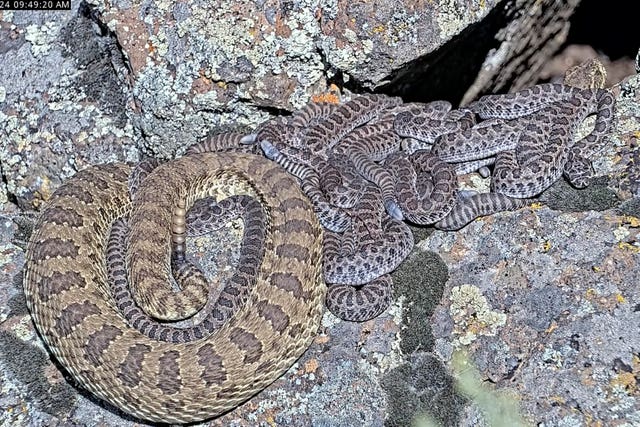Scientists use video to monitor ‘mega-den’ of hundreds of rattlesnakes
The precise location of the den in Colorado is being kept secret to prevent the reptiles being disturbed.

A “mega den” of hundreds of rattlesnakes in Colorado is getting even bigger now that late summer is here and babies are being born.
Thanks to livestream video, scientists studying the den on a craggy hillside in Colorado are learning more about these enigmatic – and often misunderstood – reptiles.
They are observing as the youngsters, called pups, slither over and between adult females on lichen-encrusted rocks.
The public can watch too on the Project RattleCam website and help with important work including how to tell the snakes apart.

The project is a collaboration between California Polytechnic State University in San Luis Obispo, snake removal company Central Coast Snake Services and Dickinson College in Carlisle, Pennsylvania.
By involving the public, the scientists hope to dispel the idea that rattlesnakes are usually fierce and dangerous.
In fact, experts say they rarely bite unless threatened or provoked and often are just the opposite.
Rattlesnakes are among the few reptiles that care for their young. They even care for the young of other rattlesnakes.
The adults protect and lend body heat to pups from birth until they enter hibernation in mid-autumn, said Max Roberts, a CalPoly graduate student researcher.
“We regularly see what we like to call babysitting, pregnant females that we can visibly see have not given birth, yet are kind of guarding the newborn snakes,” Mr Roberts said on Wednesday.
As many as 2,000 rattlesnakes spend the winter at the location on private land, which the researchers are keeping secret to discourage trespassers.
Once the weather warms, only pregnant females remain while the others disperse to nearby territory.
There are 36 species of rattlesnakes, most of which inhabit the US.
They range across nearly all states and are especially common in the south west. The ones being studied are prairie rattlesnakes, which can be found in much of the central and western US and into Canada and Mexico.
Like other pit viper species but unlike most snakes, rattlesnakes do not lay eggs. Instead, they give birth to live young. Eight is an average-size brood, with the number depending on the snake’s size, according to Roberts.





